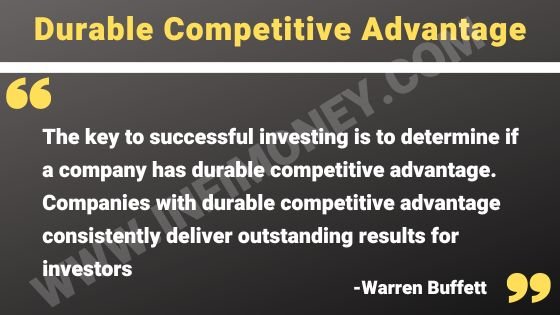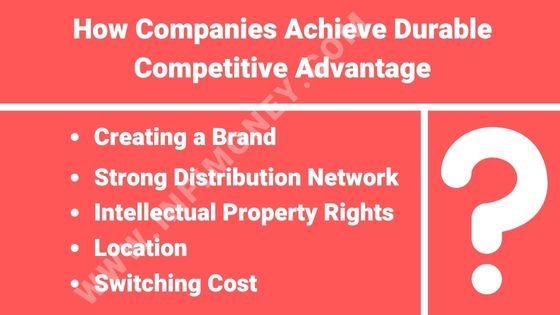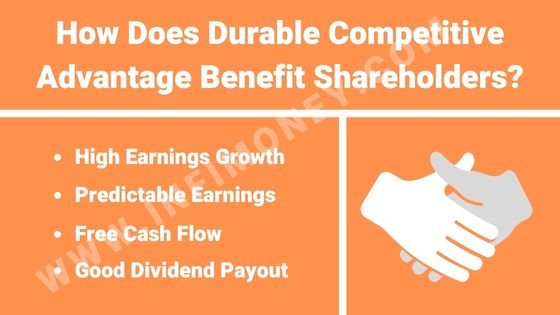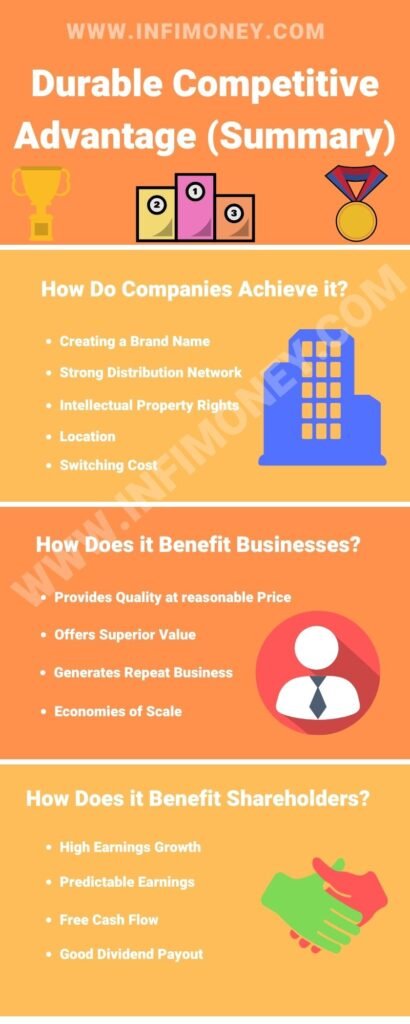Durable Competitive Advantage, is a fundamental concept of value investing. Investors like Warren Buffett, Peter Lynch and many more have always advocated for the importance of durable competitive advantage as one of the most crucial factor that determines the long term success, sustainability and longevity of a business.

In this post we are going to discuss the following points:
- What is durable competitive advantage?
- How do Companies create Durable Competitive Advantage?
- How does Durable Competitive Advantage Benefit Businesses?
- How does Durable Competitive Advantage Benefit Shareholders?
Durable competitive advantage is a sustainable factor that provides a business an edge over its competitors, thereby protecting the earnings power of a company from being taken over by competitors.
While discussing durable competitive advantage, it is also important to understand what an economic moat is, a term, coined by Warren Buffett.
In the medieval times, castles had wide moats around them that protected them from being invaded by attackers.
What are moats? They were wide water bodies all around the castle that made it inaccessible for foreigners unless someone from inside the castle allowed them to enter.

Durable Competitive Advantage: How do Companies achieve it?
Companies with durable competitive advantage have one or more of these factors in their business:
Brand
Every brand has trust of quality behind it, and people prefer a branded product over generic ones because of the assurance of consistency of quality.
As a result, a strong brand increases a customer’s desire to purchase its product or service. This also allows brands to command a premium pricing on their products, thereby increasing their profit margins.
For Example: People like Domino’s because the brand name ensures no matter where they order the pizza, the taste and the overall experience is going to be consistent. Because of this consistency, people prefer visiting Domino’s Pizza over any other brand.
Distribution Network
Another way companies can create durable competitive advantage is by creating a strong distribution network.
Companies with strong distribution network allows them to penetrate deeper in the market and successfully cater to larger customer base, adding more sales and profit.
Intellectual property (copyright, patent, trademarks):
Another, and probably the strongest ways companies can create durable competitive advantage is by creating intellectual property.
Intellectual property usually contains copyright, patents and trademarks that protect a business and its products from being copied by competitors.
To illustrate, patents filed by pharmaceutical companies provide exclusive right to the company to manufacture the product for a specific period of time.
For Example: Coca-Cola has its beverage formula patented and kept as a secret so that none of its competitors is able to copy their formula and threaten their monopolistic position in the market.
Location
This is something very uncommon but there are times when being on the right place could create a huge durable competitive advantage. Locations can be a huge durable competitive advantage if it is difficult to copy for competitors.
For Example: NESCO a company that owns and operates Bombay Exhibition Center (BEC), has great advantage because of its location. BEC is located near Western express highway, a premium location which was bought by the company many years ago.
Since the land was acquired so many years ago at a very cheap price, it will be hard for any of the competitors to start another exhibition center in the same location as the price of the land would make the business unviable.
It is because NESCO bought the land so early that makes operating the exhibition center profitable which cannot be done by any one else in present scenario.
Switching cost
Switching cost refers to how difficult it is for a customer to switch its preference from product offered by Company A to Company B. Higher the difficulty, higher the switching cost.
Switching cost can also act as a durable competitive advantage for companies.
To illustrate, if you are an Apple I-phone user, switching to an android may be difficult as you have to reload or copy all the apps, contacts, and other data from I-phone to android, and some of the files may not be compatible with the new operating system.
So how does durable competitive advantage benefit a business? What are the advantages of durable competitive advantage that a business can have.

Durable Competitive Advantage: How does it Benefit Businesses?
Below are few advantages a business can reap if it has a durable competitive advantage:
Provides quality at a reasonable price
Businesses that create durable competitive advantage by creating a product differentiation or through low pricing attract large percentage of typical target market.
This allows businesses to capture larger market share, thus, creating almost a monopoly, driving competitors away from acquiring their customers.
Companies of different sectors use different strategies to attract more customers.
For example, companies that deal in “Commodity type” products with little product differentiation (such as iron and steel, power, etc), have to rely on lower pricing to gain more customers, while the companies that are able to create product differentiation (such as FMCG business, food processing, and service based business) create a durable competitive advantage by offering a better solution to the existing problem.
While there is nothing wrong in creating durable competitive advantage based on pricing, the problem with this strategy is that in the long term, it does hurt profit margins of the company, especially if there is a rise in raw material prices or operating expenses.
Companies that create durable competitive advantage based on product differentiation successfully create better moat, and cause more discerning buyers to pay more for the overall better solution.
Offers superior value
In a world of intense competition, where companies are willing to spend millions to get few customers, creating a business that does not have to fight its competitors for customers seems like a dream.
However, there are many businesses that get great number of customers without becoming a part of this cut throat competition.
Durable competitive advantage prevents your business from engaging in a very expensive battle for customers by providing superior value over its competitors.
For example, imagine two toothpaste companies, offering two different products at almost the same price, one offering a toothpaste that cleans your teeth, but the other one is offering toothpaste that not only cleans your teeth but also helps fight cavities, which one would you choose?
Since the second company is providing superior value (in terms of additional protection against cavities) over the first one, most consumers will prefer to choose the latter over former, providing more business to the second company.
Secondly, consistency of quality also plays a crucial role in attaining durable competitive advantage. When a company provides same, superior experience to its customers on a consistent basis, it gives them a feedback that they will get the same quality for the money spent, helping them recognize superior value.
For example, Coca-Cola beverages taste the same across the globe, providing the same experience to their consumers for the price paid.
This consistency of quality establishes a trust in the mind of consumers that the company will provide the same experience to them no matter where they buy its products.
Put simply, when businesses establish excellence in quality and provide consistent experience, customers recognize superior value.
Generate repeat business and loyalty
Another big advantage of establishing durable competitive advantage is that it generates repeat business and establishes customer loyalty.
This encourages customers to keep coming back again and again for the same experience, thereby allowing a business to get repeat revenue and create a loyal customer base.
One of the biggest advantages of having repeat business and loyal customer base is that companies do not have to keep spending on advertising and marketing of their business in order to acquire new customers and can generate consistent revenue from the existing customer base they already have.
Also, loyal customers often may recommend good products or services of your company to their friends and relatives, who want the same benefit, thereby helping business acquiring new customers without incurring any expense on customer acquisition.
One of the best examples of word to mouth publicity is Google. Google in its initial days never advertised about its services and relied completely on word to mouth publicity for its marketing.
Slowly, as the word started spreading about how helpful Google was, more and more people started using its services.
Economies of scale
When companies have clear durable competitive advantage, you gain the benefit of economies of scale, as you don’t have to invest a lot in marketing and advertising to get customers to your door. A durable competitive advantage becomes your cash cow.
In other words, once you have a durable competitive advantage, you don’t have to spend a lot on research, development and promotion. As your products start getting loyal customers and repeat sales, few smaller changes help you achieve higher sales of your products.
For Example: Nestle India launched its 2-minute noodles with a differentiation that it is easy to prepare and can be cooked in just 2-minutes.
Once the brand was established, all Nestle had to do is add more variety to existing product by adding new flavours, which it did by launching Atta noodles, oats noodles and even spicy range of noodles under sub-brand name Maggi “Hot-Heads”.
The product was largely the same (instant noodles) but because of few changes (such as flavours) there was a huge jump in sales and demand for its products.

All the points mentioned above prove that durable competitive advantage does provide businesses an edge over other its competitors.
But how is it beneficial for shareholders like you? And why should you look for durable competitive advantage in a business? In this section, I will try to explain how durable competitive advantage benefits shareholders:

Durable Competitive Advantage: How does it Benefit Shareholders?
In this section, I will try to explain how durable competitive advantage benefits shareholders:
High earning Growth
Any company that enjoys high durable competitive advantage is likely to have products and services that have high quality and distinct image. This allows companies to increase prices while maintaining profitability and sales.
This is of immense importance for shareholders as higher earnings growth leads to better and more sustainable price appreciation in stocks,
Predictable Earnings
When companies have a durable competitive advantage, their earnings growth becomes more stable and predictable.
Consistent earnings growth makes it easier for you to make future projections about earnings growth, that is how much, a company will be able to earn 5 or 10 years from today.
For Example: For the past 10 years, HDFC bank has been growing its sales and profit at consistent rate of 20%-25%. Such consistent growth in earnings shows that company is able to sustain its competitive advantage over the peers, and thus, it is easier for you to make projections about future growth of the company.
Assuming that HDFC Bank will continue to grow at 20%-25%, for the next 5-10 years, you can easily make projection about future earnings of the business, giving you a clearer idea whether you should invest in HDFC Bank or not.
Huge Free cash flow
Another great benefit shareholders get by investing in companies with durable competitive advantage is that they enjoy huge free cash flows.
Free cash flow is the cash left with the company after paying for all the expenses incurred.
Companies that enjoy sustainable durable competitive advantage are likely to invest minimal amount on research and development. This wold leave a lot of free cash, which can be used expand business in other geographies and generate higher profits from a stable product line.
For Example: When Coca-Cola became hugely popular in all of USA, company instead of spending millions on researching to create new product, decided to continue with the same product and expand its distribution network to other countries as well.
As a result, Coca-Cola is now a global brand with presence in more than 100 countries and a brand recognized by 90% of earth’s population.
Good dividend pay-out
Last but not the least, companies with sustainable durable competitive advantage also distribute handsome dividends to shareholders. What are dividends? It’s a part of company’s profit which it decides to distribute to its shareholders.
When companies have lot of free cash, and do not have any foreseeable expansion plans, they usually use this extra cash to pay out dividends to shareholders.
For Example: Hindustan Unilever (HUL), one of the leading FMCG Company in India, distributes almost 80-90% of its profits as dividends.
This could be a great investment for those investors who are looking for a stock for a regular source of income and do not bother much about price volatility in the stock market.
Before we conclude this post on durable competitive advantage, here is a simple info-graphic that sums up the entire post:

Conclusion
The process of identifying durable competitive advantage is a three step process, where in the first step process which involves asking three questions. First.
Has the company got a unique product or a business model to offer to its customers? If the answer is a yes, then the company has some economic moat, else not.
The second question is, what factors contribute to the durable competitive advantage to the company? Higher the number of factors, stronger the advantage if you cannot find any, it has none, and you should proceed to the final question, which is, how strong is the advantage, is the economic moat broad or narrow? Finally, is it sustainable for the long term?
It is important to note that durable competitive advantage can be constantly challenging for existing companies and is also vulnerable to structural shifts in the industries as well.
A company’s durable competitive advantage can also be challenged if it tries to enter new and unknown market or industry. You should always be looking for such scenarios as this can decrease a company’s long term growth, profits and returns and thus it is critical for you to keep monitoring your investments in an on-going basis.